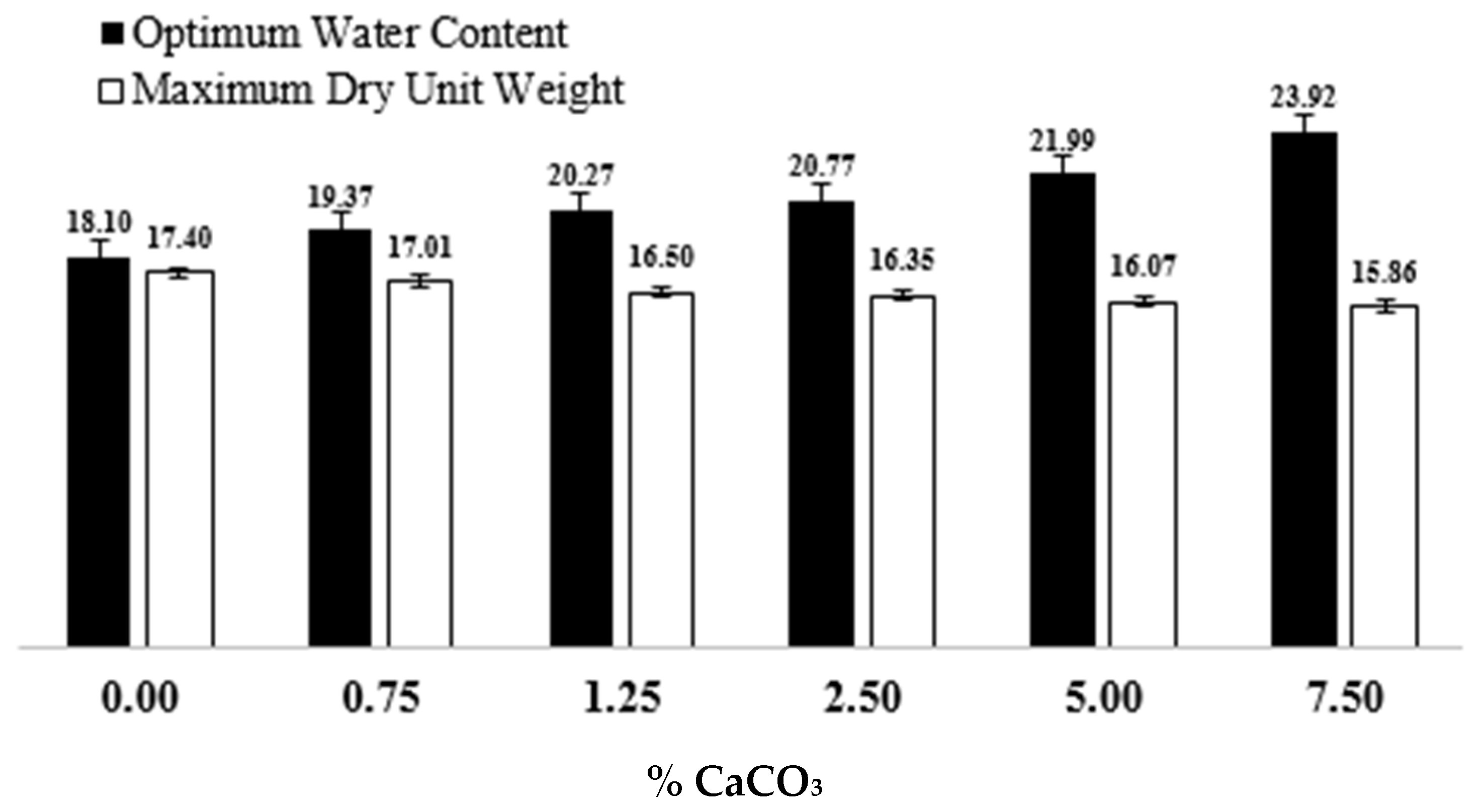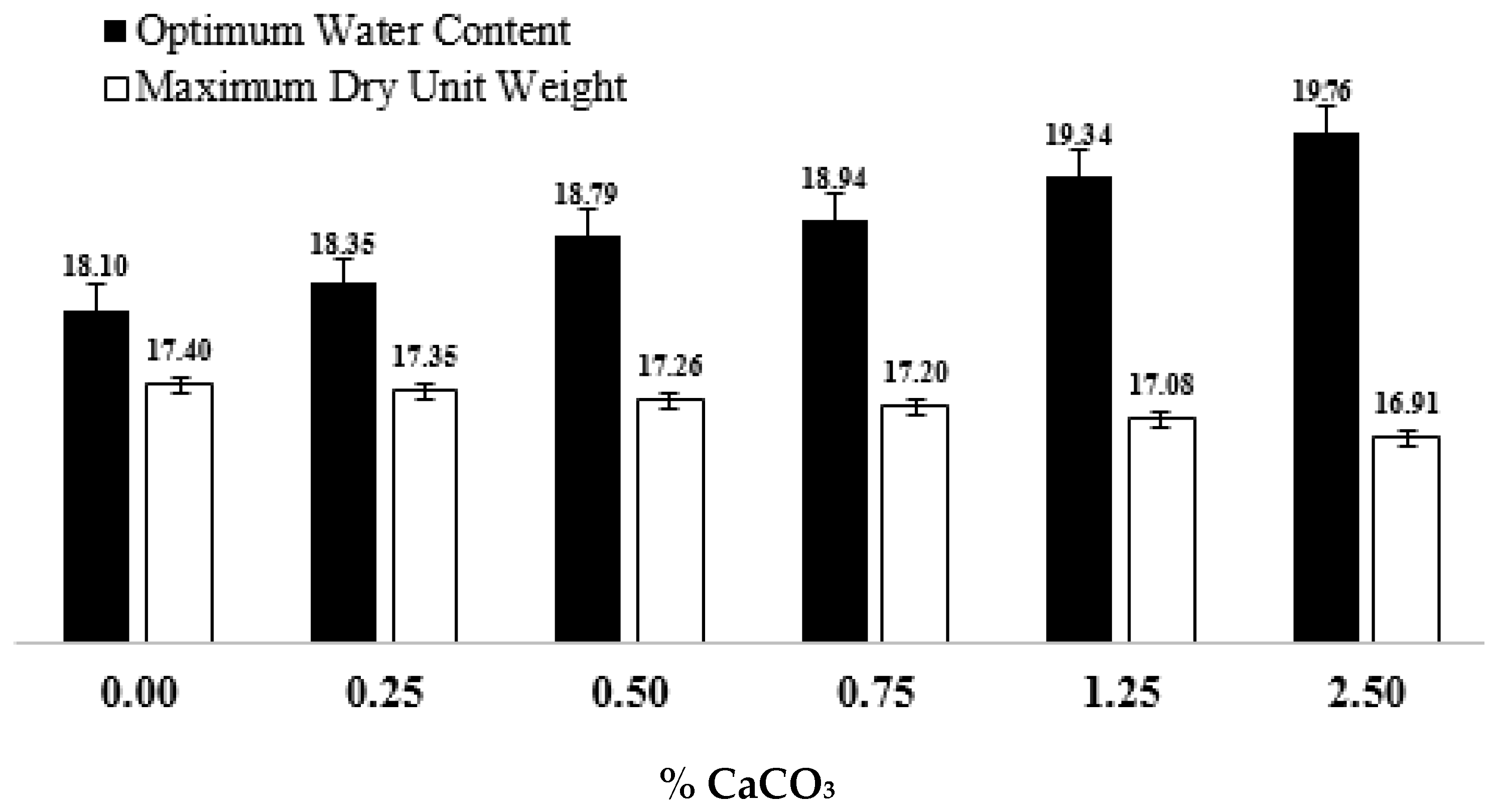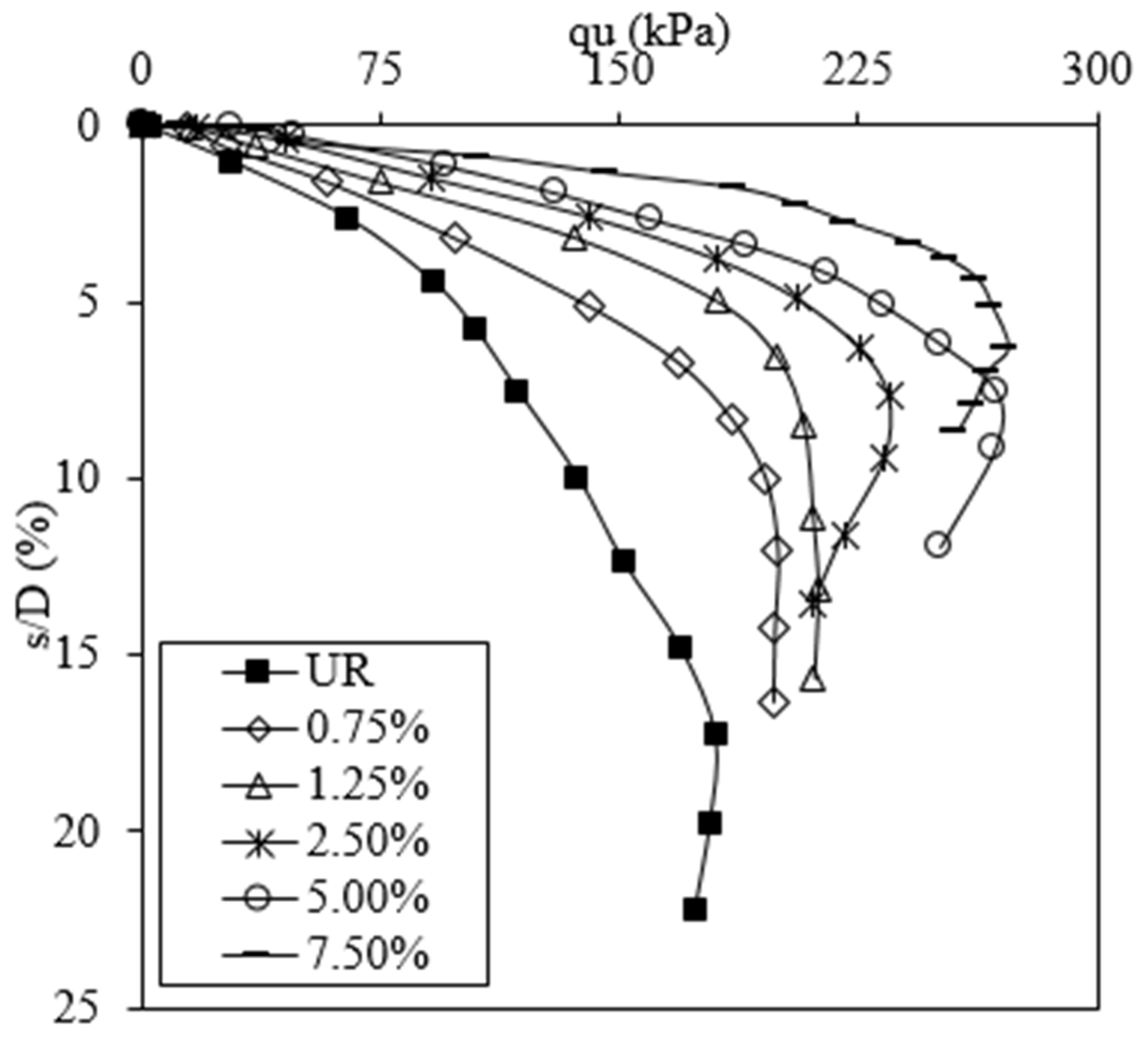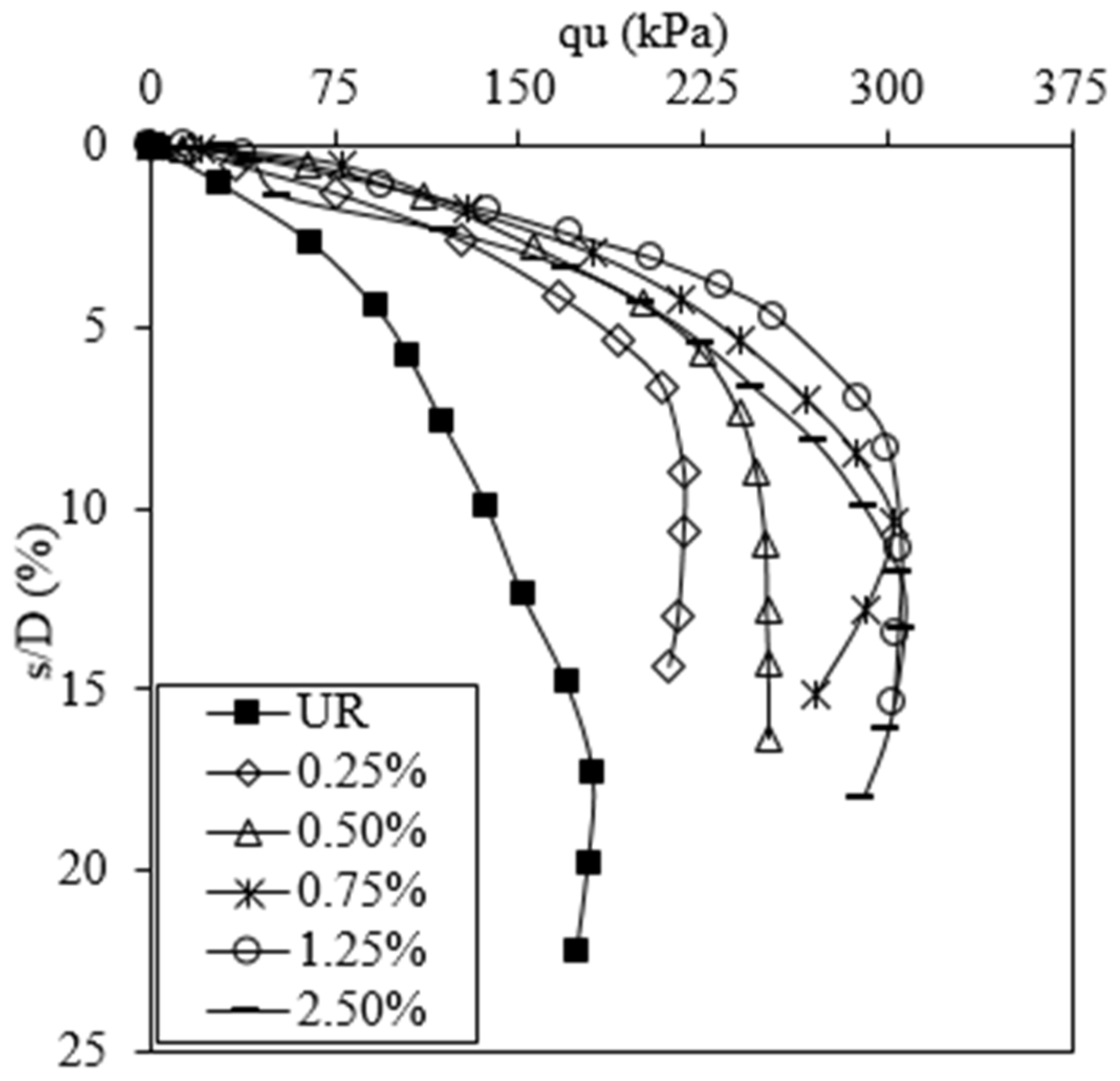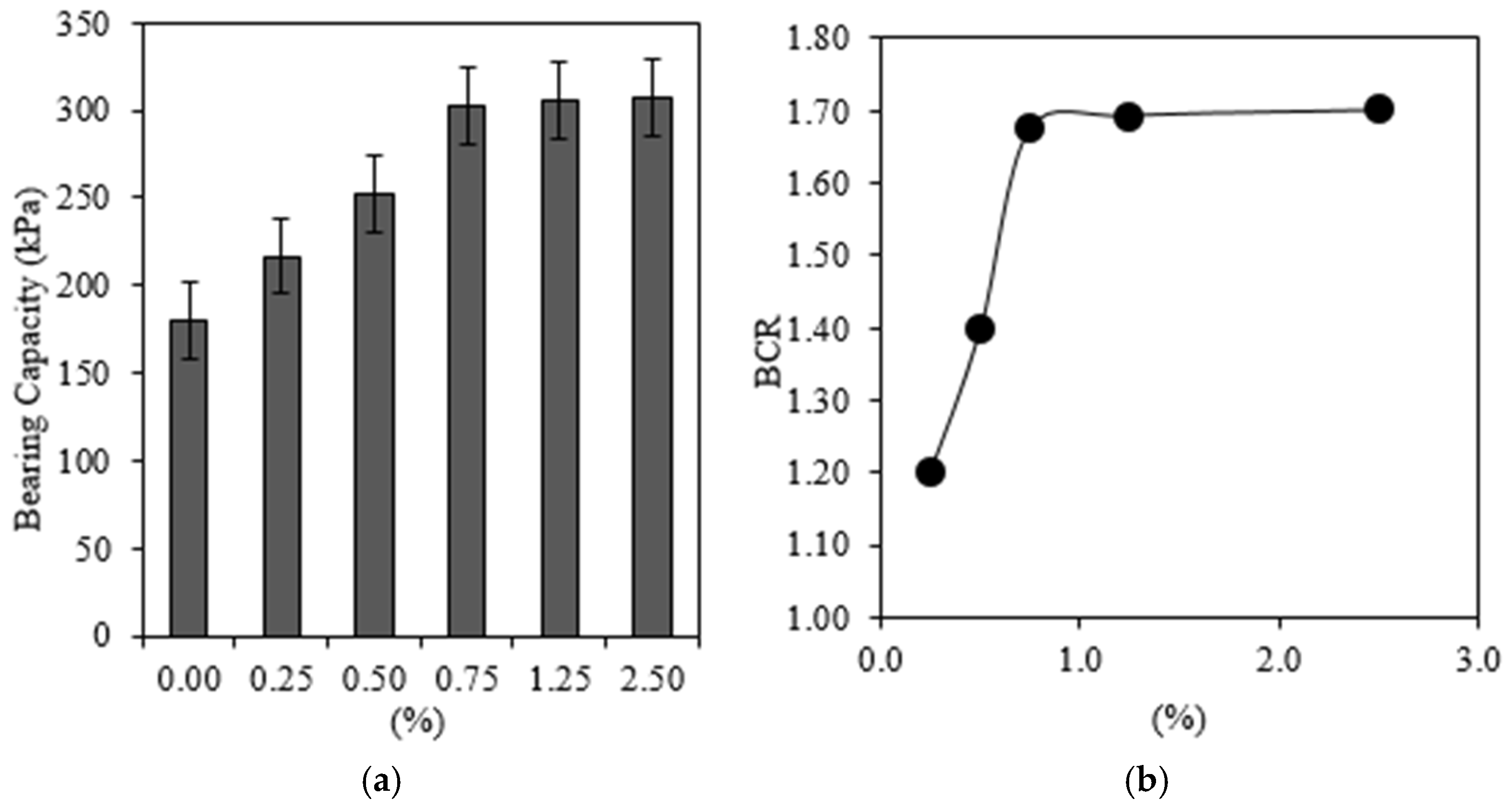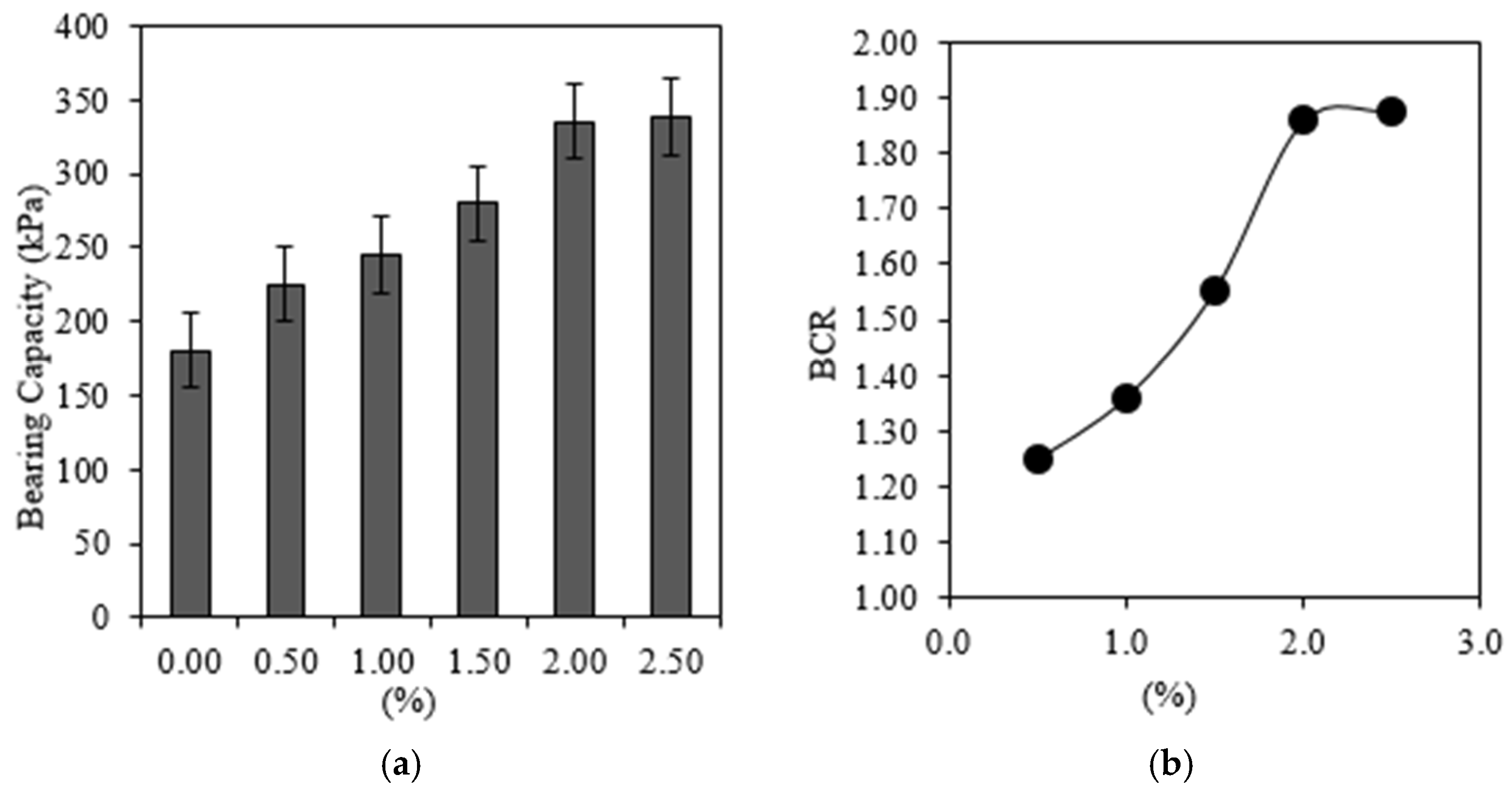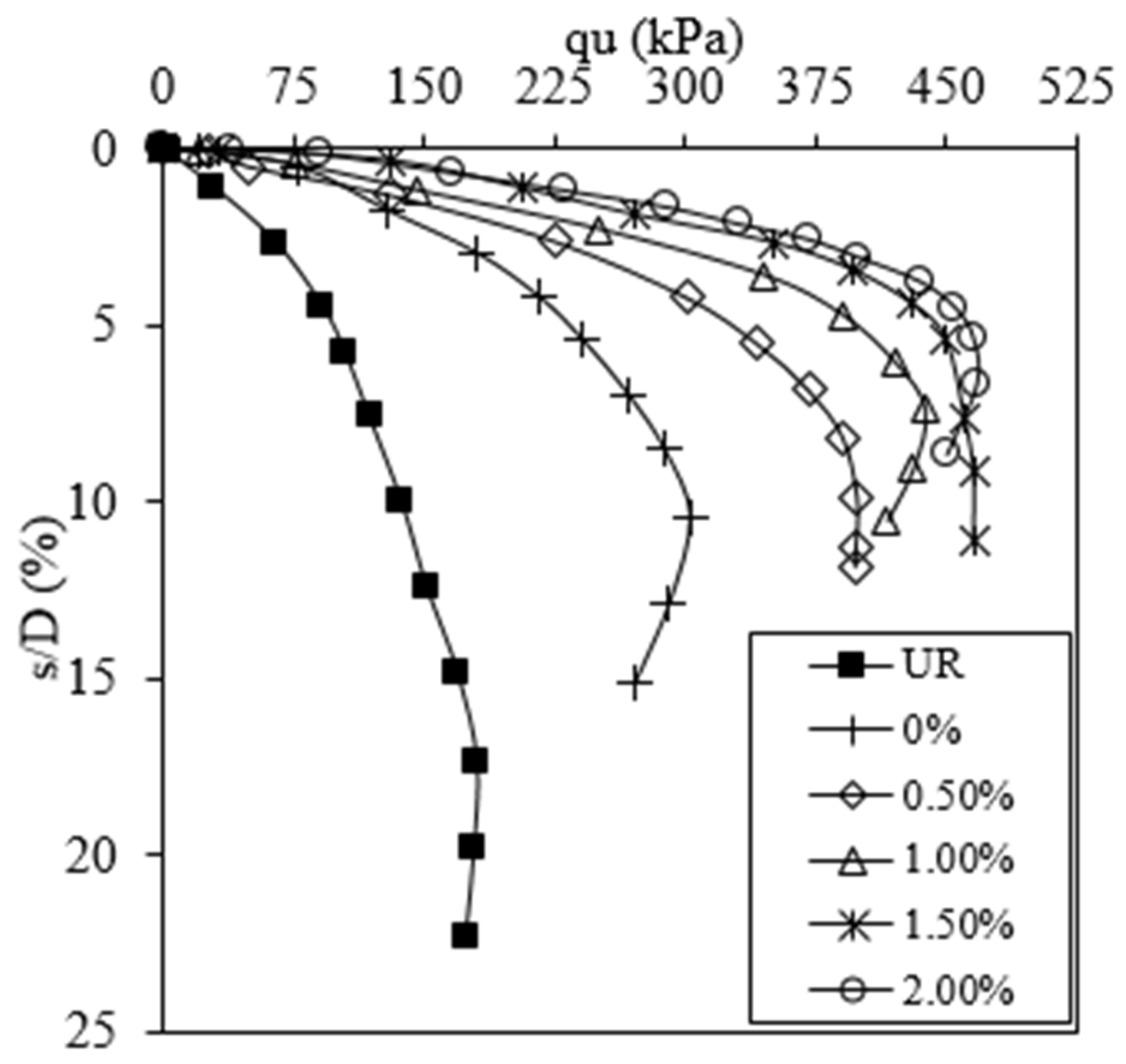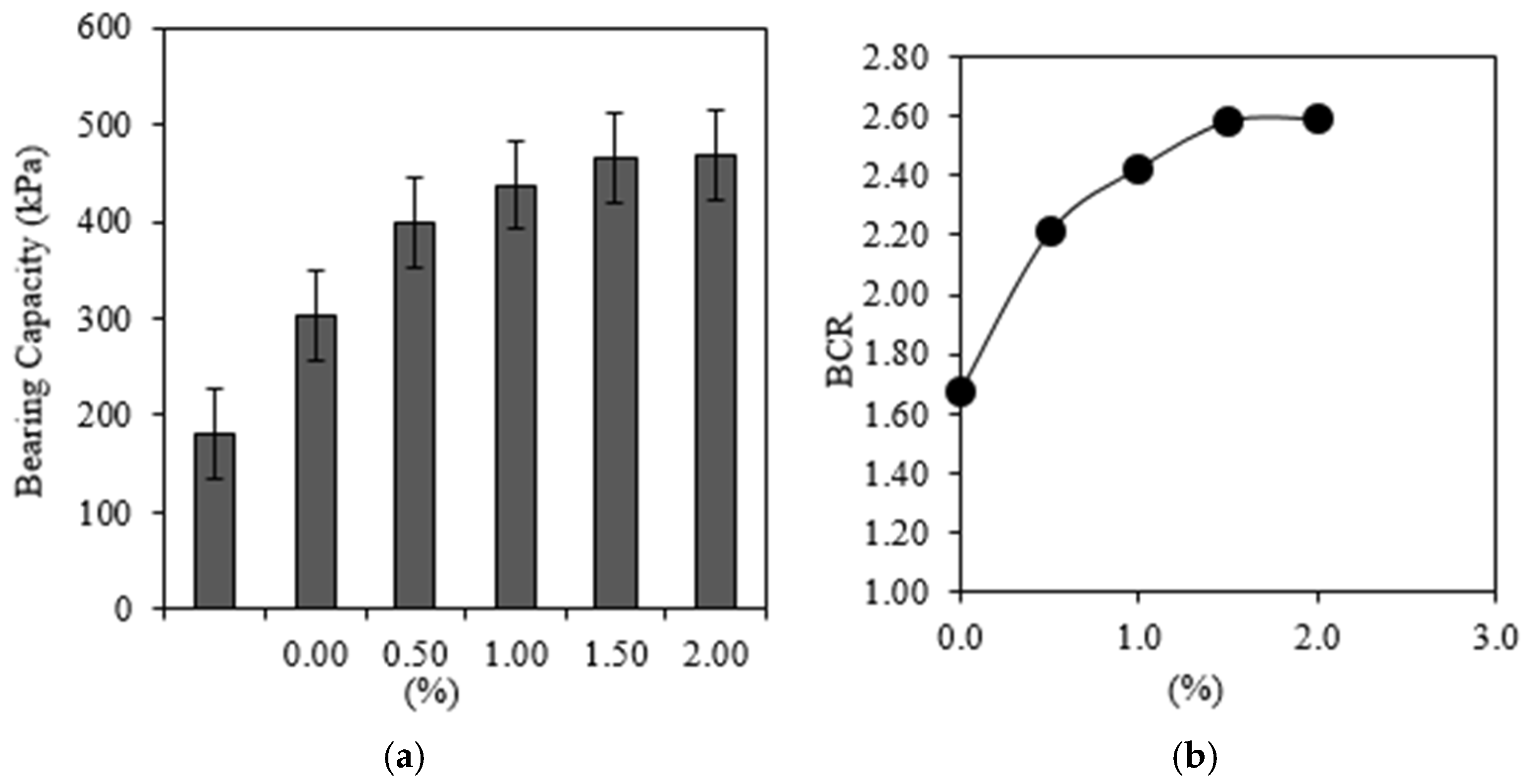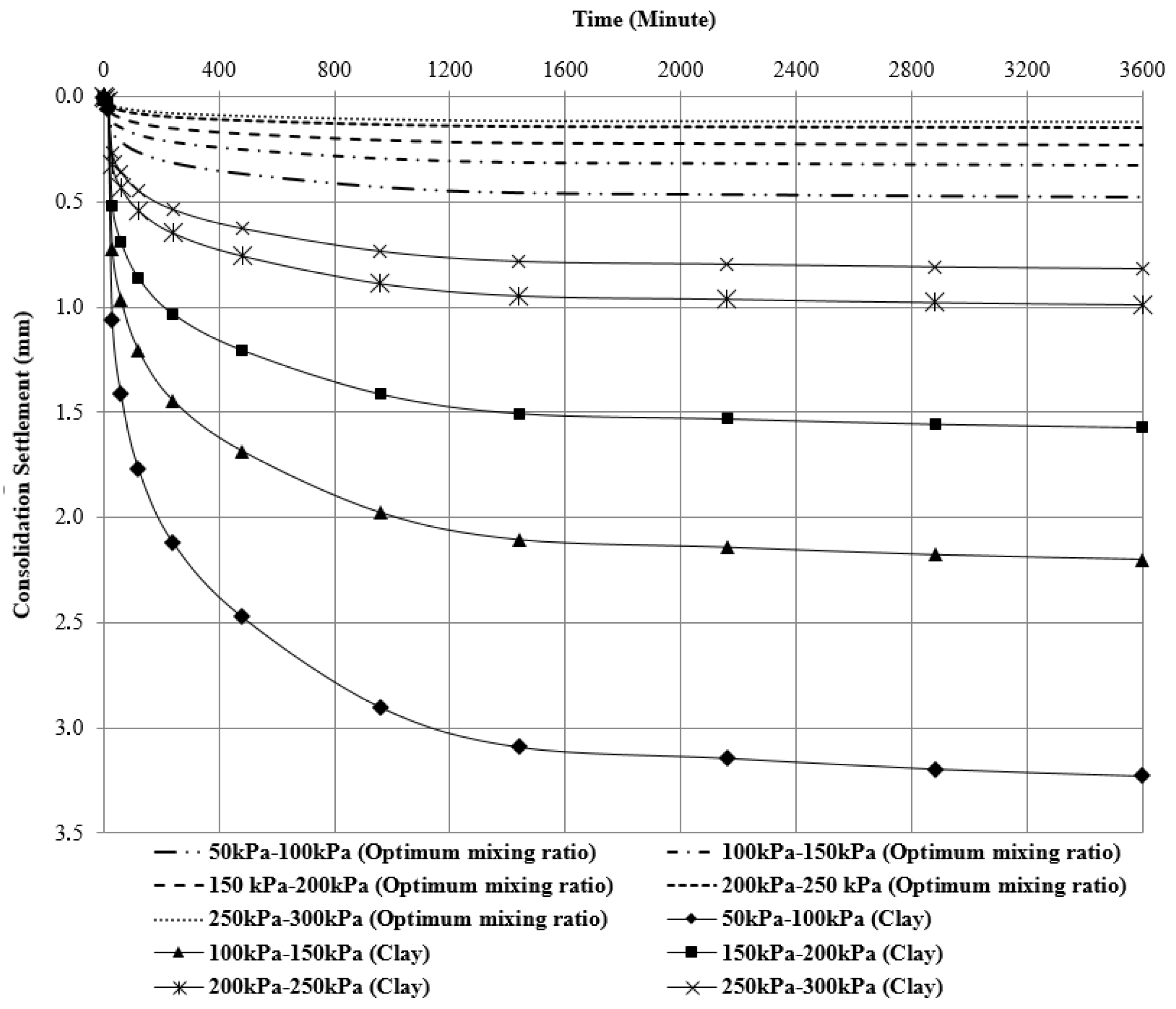1. Introduction
The scarcity of suitable land to build on is a significant problem worldwide. There is not enough affordable existing land that satisfies the necessary geotechnical building criteria. Attempts to solve this involve ways of enhancing areas with problematic soil conditions to allow their subsequent use, such as stabilization, grouting, or compaction. However, most methods used are considered relatively expensive, very labor intensive, and appreciably time consuming [
1]. To eliminate these problems, geotechnical engineers search for suitable soil additives to allow the resulting soil media to meet the desired engineering criteria.
The relevant published literature includes scientific studies of treatments involving the use of several strengthening agents for different soil media. These include an investigation of the use of recycling used tires [
2], recycled asphalt pavement [
3], pond ash [
4], fly ash [
5], cement bypass dust or cement kiln dust [
6], waste stone powder [
7], waste material from construction and demolition sites [
8], rice husk ash [
9], biopolymers [
10], glass manufacturing waste [
11], geopolymers [
12] and steel slag [
13].
The combined use of traditional soil stabilization agents and chemical improvement compounds contributes to climate change by emitting greenhouse and pollutant gases such as CO
2, SO
2, and NO
X, and poses environmental toxicity risks by generating additional toxic by-products that contaminate both soil and groundwater [
14,
15]. Consequently, the use of more environmentally friendly alternatives is currently a topic of interest in geotechnical engineering when considering environmental protection and reducing the use and associated costs of chemical compounds to strengthen the soil.
Environmentally friendly nanomaterials are one group of soil improvement materials that offer significant advantages in areas with problematic soil conditions [
16,
17,
18]. In addition, ecologists have raised the importance of putting research into nanomaterials at the forefront because quantitative measures allow a successful evaluation of ecological risk [
19,
20].
The high specific surface areas of most nanomaterials permit their interaction with expansive clay particles [
21]. Generally preferred nano additives for soil enhancement procedures in geotechnical engineering include nano-bentonite, nano-laponite, nano-alumina, nano-silica, nano-clay, nano-copper, nano-CuO, nano-MgO, carbon nanotubes and nano-zeolite.
As documented by other studies on nanomaterials, adding nano-silica to soils, even at remarkably low percentages from 0.7 to 3%, either on its own or with other traditional additives like cement and lime, significantly impacts not only the soil microstructure but also the physical and chemical properties of soils, as well as improving compressibility, resistance and unconfined compressive strength [
22,
23,
24,
25,
26,
27,
28,
29,
30].
Carbon nanotubes are essentially a sheet of graphene rolled into a cylinder and are the strongest and stiffest material yet discovered, being 100 times stronger than steel but 6 times lighter [
31]. Amounts as small as 1 to 3% can substantially improve the compressive strength of soils [
32].
Similarly, the use of nanomaterials, such as nano-bentonite [
33,
34] and nano-laponite [
35,
36], show exceptional improvements in the geotechnical properties of soils, even at percentages as low as 1 to 10% by lowering the liquefaction potential and increasing their compressive strength. Mohammadi and Niazian [
37] investigated nano-clay and found that adding 1.5% nano-clay montmorillonite into soils significantly improved their unconfined compressive strength and California Bearing Ratio (CBR) values.
As one of the more recent trends in geotechnical engineering, due to their environmentally friendly nature and remarkable strengthening abilities, nanomaterials have been considered in this study. To investigate their effects on various soil parameters, both traditional and large-scale laboratory model experiments were performed on clay soil samples treated with CaCO3, nano-CaCO3 and Glass Fiber Chopped Strands (GFCSs) in varying ratios. The following sections of this study present the results in the form of correlated graphical representations and related comments.
2. Materials and Methods
2.1. Material
The materials used in the experimental studies were clay soil from Adana City, Turkey, along with CaCO
3, nano-CaCO
3 and Glass Fiber Chopped Strands (GFCSs), all from İstanbul, Turkey. The engineering properties of the clay soil were acquired according to the ASTM Standards (ASTM D6913/D6913M, ASTM D698, ASTM D4318 and ASTM D2487). The gradation (particle size distribution) curve of the clay soil is given in
Figure 1 below [
38].
Thereafter, the soil’s specific gravity (27 kN/m
3), liquid limit (42%), plastic limit (24%), plasticity index (18%), maximum dry unit weight (17.40 kN/m
3) and optimum water content (18%) were obtained [
39,
40] and it was classified as a clay with low plasticity (CL) [
41]. The chemical content of the soil determined via X-ray fluorescence analyses (XRF) is presented in
Table 1, the properties of CaCO
3 and nano-CaCO
3 are given in
Table 2,
Table 3 and
Table 4 and the properties of GFCSs are given in
Table 3. GFCSs, the basic material of which is silica sand, is the raw material of glass. GFCSs possess a structure which does not decompose, mildew, corrode, oxidize and become eradicated by micro-organisms in soil over time. For the experiments, GFCS samples were prepared in 3.0, 6.0, 9.0, 12.0 and 25.0 mm lengths and 9 μm–13 μm diameters.
2.2. Method
Block samples taken from Adana City were triturated, dried for 24 h under a steady temperature of 105 ± 5 °C and, afterwards, pulverized using a grinder. Index properties of the taken samples and prepared mixtures were obtained by means of performing traditional laboratory experiments like sieve analysis, pycnometer and proctor compaction. CaCO
3 and nano-CaCO
3 were mixed uniformly with dry clay samples at varying ratios. Then, water was added to the prepared mixtures at the optimum ratio and mixed until uniformity was reached. Afterwards, GFCS-mixed new samples were prepared and then mixed with water until reaching uniformity to carry out further tests. All samples were cured in 5 kg bags in a curing room for 24 h to preserve their moisture content. According to the standards, lime specimens such as cubes, floor screeds and soil–lime mixtures should be cured in controlled environmental conditions. Specifically, the curing environment must maintain a stable temperature of 20 ± 2 °C (i.e., between 18 °C and 22 °C) to ensure proper hydration and strength development. Additionally, the relative humidity should be maintained at a minimum of 95%, with values typically exceeding 98% to minimize moisture loss and prevent surface drying [
45,
46] (ASTM C511, 2020; EN 12390-2, 2019). Subsequently, tests were conducted on the samples with the use of a model cylindrical testing case 600 mm in height and 600 mm in diameter which was produced using steel bars 10 mm in thickness. A circular model footing was placed on the sample concentrically with the model testing case. Compaction of the 25 mm-thick samples was carried out by dropping a custom-manufactured 2 kg mallet 80 times for each layer from a 200 mm elevation inalterably onto the model footing [
47]. Water content and uniformity of the sample surfaces were checked when required. Vertically applied loads on the model footing and settlements at two evenly designated places from the center of the model footing were read by two ESIT Inc-manufactured load cells and ELE Inc-manufactured electronic vertical displacement transducers, respectively, which were all assembled into the testing case at specified locations. The average of the two readings were used as displacement values. The required steps such as resetting the gauge readings and verifying the uniformity of the applied loads were followed throughout all the testing procedures. Loads were implemented in a vertical and static manner onto the model footing. Load and displacement values were then transferred to a data collection device with 32 conduits. Afterwards, they were transformed into numeric values by means of geotechnical software (DS7 DataSystem 7.3). The values of vertical loads, settlements and stress values were acquired for all the conducted tests.
The boundary effect was also considered for the testing case by mounting strain gauges onto the edges of the case, resetting them all to zero and observing them as the loads were applied—all the reading values in the gauges stayed constant [
11].
The experimental configuration developed for this study is presented in detail in
Figure 2. The setup was specifically designed to evaluate the settlement behavior of soil samples subjected to vertical loading, simulating shallow foundation conditions. The system is constructed on a rigid steel frame with bolted joints to ensure structural stability and to prevent horizontal or torsional displacement during loading operations. At the top of the frame, a servo-controlled vertical load motor is installed to apply monotonically increasing static loads to the test specimen. The load is transmitted through a vertical loading rod to a rigid steel foundation plate placed on the surface of the soil sample. The motor’s load application is displacement-controlled to enable fine-tuned loading sequences and ensure gradual settlement response capture. To measure the applied load with high accuracy, a strain-gauge-based load cell (model: ESIT LCT series) is positioned in-line between the motor and the loading rod. The load cell continuously records the applied vertical force and transmits data to the acquisition unit for real-time monitoring and analysis. The foundation plate used to represent a shallow footing is fabricated from stainless steel, with dimensions of 100 mm × 100 mm × 20 mm (width × length × thickness). The base of the plate is machined flat to ensure uniform load distribution across the contact area. The plate rests directly on the prepared surface of the clay specimen, which is compacted in a cylindrical mold with dimensions of 600 mm diameter and 600 mm height to simulate field conditions under controlled laboratory parameters. To capture vertical settlements accurately, two high-sensitivity Linear Variable Differential Transformers (LVDTs) (model: ELE International) are symmetrically installed on either side of the foundation plate. These transducers are mounted on independent fixed frames isolated from the loading system to eliminate measurement errors due to system vibration or lateral movement. The LVDTs provide redundant readings to increase the reliability of displacement measurements and to detect potential tilt or eccentric loading during the test. The load and displacement signals are collected through a 32-channel data acquisition system (sampling frequency: 10 Hz, voltage range: ±10 V) that allows simultaneous monitoring of all measurement channels. The system is equipped with signal conditioning modules, analog-to-digital converters, and software-based data logging capabilities. This allows for the real-time graphical output of load versus settlement behavior, as well as post-test processing and numerical analysis. Throughout the test, the system operates under room temperature (20 ± 2 °C) and a controlled relative humidity of approximately 60–65% to minimize environmental effects on material behavior. Soil specimens are conditioned for 24 h prior to testing, and tests are repeated three times for each mix design to ensure statistical reliability. All mechanical components and sensor placements were calibrated prior to testing. The detailed layout and interaction of system components are illustrated in
Figure 2.
3. Results
3.1. Effect of Water Content and Mixing Ratio
The optimum water ratio to be implemented into the sample mixtures was obtained via a series of compaction tests. Based on the experimental results presented in
Figure 3 and
Figure 4, an increase in the proportion of CaCO
3 additive leads to a significant rise in the optimum moisture content required for the compaction of clay soil, reaching up to 1.32 times the original value. Correspondingly, the maximum dry unit weight of the clay soil decreases by up to 1.10 times. In the case of nano-CaCO
3 incorporation, the optimum moisture content increases by up to 1.10 times, while the maximum dry unit weight experiences a reduction of up to 1.03 times. These trends indicate that the addition of CaCO
3, particularly in nano form, influences the compaction characteristics of clay soils by modifying their moisture–density relationship. It was observed that as the ratio of nanomaterial added into the soil samples was increased, the required amount of water in the mixtures increased as well. This event originates from the water absorption capability of Ca in CaCO
3. Comparatively, nano-CaCO
3 exhibits a more stable behavior in terms of required water content and unit weight alterations which makes it a better alternative to CaCO
3.
3.2. Influence of CaCO3 on the Bearing Capacity of Clay Soil
With the utilization of CaCO
3 at 0.75%, 1.25%, 2.5%, 5.0% and 7.5%, bearing capacity increments of up to 1.11, 1.18, 1.30, 1.49 and 1.51 times were encountered in comparison to the unimproved soil samples, respectively. Improvements were observed in the bearing capacity and settlement parameters of clay soil samples for all ratios of CaCO
3 implementation. While low degrees of engineering improvements took place at lower ratios of CaCO
3 addition, the highest improvement values were reached at 5%. After exceeding 5%, the improvement ratios continued at modest amounts until reaching a halt. Hence, 5% was chosen as the optimum ratio of CaCO
3 implementation into clay soil samples for initiating a chemical reaction which leads to improved soil conditions. Similar studies in the relevant literature, within the context of the addition of various ratios of (2.5–20%) CaCO
3 to clay samples having different properties, where CBR tests were conducted as a different approach compared with the current study, point out that the optimum CaCO
3 ratio should be taken as 5% as well [
48,
49,
50,
51].
The related graphics are presented, below, as
Figure 5 and
Figure 6.
Figure 5 presents the load–displacement curves corresponding to varying proportions of CaCO
3 additive.
Figure 6a illustrates the bearing capacity values obtained from the peak points of the curves in
Figure 5.
Figure 6b, on the other hand, provides a comparative analysis of these bearing capacities in a non-dimensionalized form to highlight the relative effects of additive content.
3.3. Influence of Nano-CaCO3 on the Bearing Capacity of Clay Soil
The implementation of nano-CaCO
3 at 0.25%, 0.50%, 0.75%, 1.25% and 2.50% resulted in bearing capacity increment ratios of up to 1.20, 1.40, 1.68, 1.69 and 1.70 compared with the unimproved soil conditions, respectively. Significant improvement ratios were obtained at lower ratios of nano-CaCO
3 utilization. Up to the ratio of 0.75%, CaCO
3 addition led to increasing degrees of improvement, after which a nearly constant state was reached. Hence, the optimum ratio for nano-CaCO
3 was decided to be 0.75%. Thereby, the result was reached that an additional 15% increase was recorded in the case of using nano-CaCO
3 in comparison to CaCO
3 (both at a 5% ratio) in the bearing capacity improvement of clay soil. Furthermore, with the usage of the nanomaterial, even the implementation of 0.75% rather than 5% gave an additional improvement ratio of 14.8% compared with plain CaCO
3. Therefore, as the utilization of resources is taken into consideration, the usage of the nanomaterial was observed to be a better alternative in terms of both improvement achievements and economical aspects. The details of the related cost analysis can be seen in
Section 3.4.
Figure 7 and
Figure 8 are given below to illustrate the obtained results.
Figure 7 presents the load–displacement curves corresponding to varying proportions of nano-CaCO
3 additive.
Figure 8a illustrates the bearing capacity values obtained from the peak points of the curves in
Figure 7.
Figure 8b, on the other hand, provides a comparative analysis of these bearing capacities in a non-dimensionalized form to highlight the relative effects of additive content.
3.4. Cost Analysis
Based on the previously acquired results, for the improvement of clay soil with the addition of CaCO
3 at an optimum ratio of 5% or nano-CaCO
3 at 0.75%, as an example, 0.05 m
3 CaCO
3 or 0.0075 m
3 nano-CaCO
3 is needed for 1 m
3 of clay soil. From an economical point of view, 0.582 USD (United States Dollar) is needed for the usage of plain CaCO
3 while only 0.112 USD is needed for nano-CaCO
3 (
Table 5). Therefore, it was deduced that the implementation of the nano version of the same product stands out to be the better alternative in terms of both the economic aspects and the utilization of resources.
3.5. Influence of Glass Fiber Chopped Strands (GFCSs) on the Bearing Capacity of Clay Soil
With the addition of GFCSs at 0.5%, 1.0%, 1.5%, 2.0% and 2.5%, bearing capacity enhancement ratios of up to 1.25, 1.36, 1.55, 1.86 and 1.88 were attained compared with unimproved clay, respectively (
Figure 9 and
Figure 10). The increment ratios in the bearing capacity values raised significantly up to the GFCSs addition ratio of 2.0%, after which the ratios stayed nearly constant. Hence, 2% GFCSs was chosen as the optimum utilization ratio. A more resistant structure was formed with the addition of GFCSs to clay soil media against tensile and compressive stresses transferred from foundation to soil. The reason for this phenomenon is the dissipation of transferred stresses inside of the soil by means of the elastic structure of GFCSs, which is the raw material of glass formed as a fiber by being melted down under high-pressure high-temperature conditions. By enabling the dissipation of stresses, GFCSs lead to a more stable soil structure with enhanced engineering properties.
3.6. Influence of GFCSs and Nano-CaCO3 Mixture on the Bearing Capacity of Clay Soil
It was previously found that the optimum ratio for the utilization of nano-CaCO
3 was 0.75% and that of GFCSs was 2.0% at which both materials separately led to significant enhancements in the clay soil media. By using the two materials together, nano-CaCO
3 at the optimum ratio and GFCSs at 0.0%, 0.5%, 1.0%, 1.5% and 2.0% ratios, bearing capacity improvement ratios of up to 1.68, 2.21, 2.43, 2.58 and 2.59 were reached in comparison with the unimproved clay state. Eventually, the optimum ratio for GFCSs was specified to be 1.5% when used with the optimum ratio of 0.75% nano-CaCO
3 together. Thus, the usage of the two materials together enabled a reduction in the optimum utilization ratio of GFCSs (from 2.0% to 1.5%) along with providing significantly higher degrees of bearing capacity improvements (2.58 times) compared with the cases of using the two materials separately.
Figure 11 and
Figure 12 are presented below to illustrate the obtained results.
Figure 11 presents the load–displacement curves corresponding to varying proportions of GFCSs and nano-CaCO
3 additive.
Figure 12a illustrates the bearing capacity values obtained from the peak points of the curves in
Figure 11.
Figure 12b, on the other hand, provides a comparative analysis of these bearing capacities in a non-dimensionalized form to highlight the relative effects of additive content.
In the sequence of the occurring chemical reaction, adherence between the particles of nano-CaCO3 and the clay soil increases and nano-CaCO3 serves as a bonding agent. Thus, nano-CaCO3 provides bonding between the GFCSs additive and clay soil and leads to the occurrence of a more rigid structure. Concordantly, in such hybrid mixtures, it is advised to utilize bonding agents along with the used additive materials to improve the structure even further.
3.7. Assessment of the Consolidation Settlements
In this part, clay soil samples were subjected to a series of incrementally applied static loads at magnitudes of 50 kPa, 100 kPa, 150 kPa, 200 kPa, 250 kPa and 300 kPa to evaluate their consolidation behavior over an extended duration of 3600 min (60 h). Throughout the loading period, vertical deformation corresponding to consolidation settlements was precisely recorded to characterize the time-dependent compressibility and secondary consolidation effects inherent to the soil matrix. The experimental program incorporated the stabilization of these soil samples with nano-calcium carbonate (nano-CaCO3) and Glass Fiber Chopped Strand (GFCS) additives at their respective optimum dosages, determined from preliminary tests. The addition of nano-CaCO3, characterized by its high surface area and reactivity, enhances the soil fabric by promoting particle bonding and filler effects at the micro-scale, thereby reducing pore volume and permeability. Simultaneously, the GFCSs provide a flexible, three-dimensional reinforcement network that increases tensile strength and stiffness, helping to resist deformation under load. The results demonstrated a marked decrease in consolidation settlements for all applied stress levels in the stabilized specimens compared with untreated clay samples. Quantitatively, the synergistic effect of combined nano-CaCO3 and GFCSs application produced a reduction in the time-dependent consolidation settlements by a factor of up to 6.80. This substantial improvement is primarily attributed to two mechanisms:
Load Transfer and Distribution: The flexible GFCSs network acts as a bridging reinforcement within the soil matrix, distributing external loads more uniformly and preventing localized excessive deformation.
Particle Bonding and Fabric Improvement: Nano-CaCO3 particles chemically interact with clay minerals, enhancing interparticle bonding and reducing compressibility by limiting soil particle rearrangement during loading.
Together, these mechanisms effectively dissipate the stress transmitted from the superstructure to the subsoil, limiting the magnitude and rate of consolidation settlements. The consolidation settlement curves, which capture the deformation behavior under varying loads, and the quantitative comparisons between stabilized and untreated samples are presented in
Figure 13.
3.8. Effect of Curing Duration on the Bearing Capacities
Curing durations of 1, 7, 14 and 21 days were applied to the mixtures of clay soil, GFCS and nano-CaCO
3 at optimum ratios after which bearing capacity increment ratios of 2.58, 2.80, 3.48 and 3.49 were reached, respectively, in comparison to the uncured samples—as can be seen in
Figure 14 and
Figure 15. Curing durations were understood to be directly proportionate to the bearing capacities. The increases in the bearing capacities were significant until the end of the 14 days and seem to stay almost constant after. The impact of nano-CaCO
3 was the most effective in the mixtures which chemically reacted with clay soil and led to time-dependent increases in the bearing capacities along with reductions in the settlement values. On the other hand, since a reaction was not possible between the GFCSs and the clay soil, the GFCSs did not have a significant role in the occurrence of time-dependent improvements. Depending on the duration of the hydration reaction taking place between nano-CaCO
3 and the clay soil, the bearing capacity and settlement values improved and the improvements stayed nearly constant after the hydration reactions reached completion.
4. Comparison with Literature Review
In this study, optimal dosages of 5% CaCO3, 0.75% nano-CaCO3 and 2.0% GFCSs (or 1.5% GFCSs when combined with nano-CaCO3) were identified to enhance soil bearing capacity and reduce consolidation settlement. Nano-CaCO3 demonstrated superior stabilization at lower dosages compared with conventional CaCO3, due to its higher chemical reactivity and better microstructural integration. The flexible fiber reinforcement system (GFCSs) improved soil tensile strength and load distribution, thereby reducing deformation and increasing structural durability. The combined application of nano-CaCO3 and GFCSs produced a synergistic effect, improving soil performance more effectively while allowing for reduced additive amounts. Additionally, a minimum curing period of 14 days was found to be necessary to complete the hydration and stabilization reactions. A reduction in consolidation settlement by up to 6.8 times was achieved, indicating a significant decrease in deformation risk, especially in problematic clay soils.
These findings align with previous studies reporting that nano-silica additions in the range of 0.7–3% improve soil microstructure, decrease compressibility and increase unconfined compressive strength [
22,
23,
24,
25,
26,
27,
28,
29,
30]. Carbon nanotubes applied at 1–3% dosage have been reported to significantly enhance soil compressive strength; due to being approximately 100 times stronger and 6 times lighter than steel, they can improve soil strength by up to 100% [
31,
32]. Similarly, the use of nano-bentonite and nano-laponite in proportions between 1 and 10% has been documented to reduce liquefaction potential and increase strength [
33,
34,
35,
36]. Moreover, the addition of 1.5% nano-clay (montmorillonite) has been shown to notably improve unconfined compressive strength and California Bearing Ratio (CBR) values [
37].
Notably, this study contributes to the literature by demonstrating that the combined use of nano-CaCO
3 and GFCSs not only enhances compressive strength but also improves tensile strength and load distribution, providing more comprehensive soil performance enhancement. The synergistic effect observed notably reduces consolidation settlement, an aspect rarely emphasized in previous research. The emphasis on curing time is consistent with prior studies highlighting the necessity of a sufficient duration for the completion of stabilization reactions involving nanomaterials [
22,
23,
24,
25,
26,
27,
28,
29,
30,
31,
32,
33,
34,
35,
36,
37].
In conclusion, this research supports the effectiveness of nanomaterials in soil improvement and offers a novel and comprehensive perspective through the multifunctional enhancements achieved by the combination of nano-CaCO3 and GFCSs.
5. Conclusions
This study comprehensively evaluated the stabilization potential of Glass Fiber Chopped Strands (GFCSs), calcium carbonate (CaCO3) and nano-calcium carbonate (nano-CaCO3) as additives for improving the geotechnical behavior of clay soils. The experimental data provide valuable insights into the individual and combined effects of these materials on bearing capacity enhancement and reduction in consolidation settlements.
As a result of this study, it was determined that the additives CaCO3, nano-CaCO3 and GFCSs used to improve the geotechnical properties of clay soils have significant effects. The application of CaCO3 at a 5% ratio promoted pozzolanic reactions and cation exchange, thereby increasing the shear strength of the soil and reducing settlements. This improvement was achieved through the interaction of Ca2+ ions with clay particles, which enhanced flocculation and reduced the void ratio. The effectiveness achieved with a low dosage supports the economic and environmental feasibility of this method.
Nano-CaCO3, even at a much lower ratio of 0.75%, produced superior results compared with traditional CaCO3 due to its high surface area and reactivity. The nano-sized particles penetrated small pores, resulting in early age bonding, denser microstructure formation and lower compressibility. This shows that the material offers significant advantages in terms of cost effectiveness and sustainability due to its high performance at low dosages.
The GFCS fibers provided three-dimensional tensile resistance to the soil, significantly improving tensile strength, ductility and crack resistance. The best results were obtained with a 2.0% fiber content, but when combined with nano-CaCO3, a 1.5% GFCS ratio was sufficient. This demonstrates a synergistic effect between chemical and mechanical stabilization, achieving a higher performance with reduced additive amounts.
In terms of curing time, it was observed that chemical reactions and fiber–soil bonding were largely completed within the first 14 days, with improvements stabilizing afterward. Therefore, a minimum curing period of 14 days is recommended for field applications.
When GFCSs and nano-CaCO3 were used together, the consolidation settlements were reduced by up to 6.8 times. While nano-CaCO3 enhanced particle bonding and soil density, GFCSs limited deformations, reducing the time-dependent settlements.
Overall, the combined use of chemical and fiber additives significantly improved soil strength, ductility and long-term performance. The success achieved with low additive ratios reduces both the costs and environmental impacts. In particular, the high efficiency of nano-CaCO3 presents a promising path for the widespread use of nanomaterials in geotechnical engineering.
This research underscores the technical feasibility and practical advantages of employing combined nano-scale chemical additives with fibrous reinforcement for sustainable and effective clay soil stabilization. The findings offer valuable guidance for geotechnical engineers seeking to optimize soil improvement techniques for enhanced infrastructure durability and safety.
Author Contributions
Conceptualization, B.B. and B.M.; methodology, B.B.; validation, B.B. and B.M.; formal analysis, B.B.; investigation, B.B., B.M. and A.Ü.; resources, B.B.; data curation, B.B. and B.M.; writing—original draft preparation, B.B. and B.M.; writing—review and editing, B.B. and B.M.; visualization, A.Ü.; supervision, B.B.; funding acquisition, B.B., B.M. and A.Ü. All authors have read and agreed to the published version of the manuscript.
Funding
This research received no external funding.
Institutional Review Board Statement
Not applicable.
Informed Consent Statement
Not applicable.
Data Availability Statement
The original contributions presented in this study are included in the article. Further inquiries can be directed to the corresponding author.
Conflicts of Interest
The authors declare no conflicts of interest.
References
- Mittal, R.K.; Gill, G. Sustainable application of waste tire chips and geogrid for improving load carrying capacity of granular soils. J. Clean. Prod. 2018, 200, 542–551. [Google Scholar] [CrossRef]
- Abbaspour, M.; Aflaki, E.; Nejad, F.M. Reuse of waste tire textile fibers as soil reinforcement. J. Clean. Prod. 2019, 207, 1059–1071. [Google Scholar] [CrossRef]
- Yokohama, S.; Sato, A. Cyclic mechanical properties of sandy soils by mixing recycled asphalt pavement material. GEOMATE J. 2019, 16, 41–47. [Google Scholar] [CrossRef]
- Arora, S.; Kumar, A. Bearing capacity of strip footing resting on fibre-reinforced pond ash overlying soft clay. Innov. Infrastruct. Solut. 2019, 4, 34. [Google Scholar] [CrossRef]
- Striprabu, S.; Taib, S.N.; Sa’don, N.M.; Fauziah, A. Chemical stabilization of Sarawak soil with class F fly ash. J. Eng. Sci. Technol. 2018, 13, 3029–3042. [Google Scholar]
- Badrawi, E.F.; El-kady, M.S. Stabilizing soft clay using geo-foam beads and cement bypass dust. Undergr. Space 2019, 5, 292–297. [Google Scholar] [CrossRef]
- Pastor, J.L.; Tomás, R.; Cano, M.; Riquelme, A.; Gutiérrez, E. Evaluation of the improvement effect of limestone powder waste in the stabilization of swelling clayey soil. Sustainability 2019, 11, 679. [Google Scholar] [CrossRef]
- Bagriacik, B.; Mahmutluoglu, B. A new experimental approach to the improvement of sandy soils with construction demolition waste and cement. Arab. J. Geosci. 2020, 13, 539. [Google Scholar] [CrossRef]
- Brooks, R.M. Soil stabilization with fly ash and rice husk ash. Int. J. Res. Rev. Appl. Sci. 2009, 1, 209–217. [Google Scholar]
- Bağrıaçık, B.; Mahmutluoğlu, B. Model experiments on coarse-grained soils treated with xanthan gum biopolymer. Arab. J. Geosci. 2021, 14, 1621. [Google Scholar] [CrossRef]
- Mahmutluoglu, B.; Bagriacik, B. Sustainable Implementation of Glass Manufacturing Waste and Geogrids in the Improvement of Fine-Grained Soils. KSCE J. Civ. Eng. 2021, 25, 1295–1307. [Google Scholar] [CrossRef]
- Phetchuay, C.; Horpibulsuk, S.; Suksiripattanapong, C.; Chinkulkijniwat, A.; Arulrajah, A.; Disfani, M.M. Calcium carbide residue: Alkaline activator for clay–fly ash geopolymer. Constr. Build. Mater. 2014, 69, 285–294. [Google Scholar] [CrossRef]
- Salimi, M.; Ghorbani, A. Mechanical and compressibility characteristics of a soft clay stabilized by slag-based mixtures and geopolymers. Appl. Clay Sci. 2020, 184, 105390. [Google Scholar] [CrossRef]
- Shafigh, P.; Bin Mahmud, H.; Jumaat, M.Z.; Zargar, M. Agricultural wastes as aggregate in concrete mixtures: A review. Constr. Build. Mater. 2014, 53, 110–117. [Google Scholar] [CrossRef]
- Vik, E.A.; Sverdrup, L.; Kelley, A.; Storhaug, R.; Beitnes, A.; Boge, K.; Grepstad, G.K.; Tveiten, V. Experiences from environmental risk management of chemical grouting agents used during construction of the Romeriksporten tunnel. Tunn. Undergr. Space Technol. 2000, 15, 369–378. [Google Scholar] [CrossRef]
- Lam, C.-W.; James, J.T.; McCluskey, R.; Arepalli, S.; Hunter, R.L. A review of carbon nanotube toxicity and assessment of potential occupational and environmental health risks. Crit. Rev. Toxicol. 2006, 36, 189–217. [Google Scholar] [CrossRef]
- Li, S.; Anderson, T.A.; Green, M.J.; Maul, J.D.; Canas-Carrell, J.E. Polyaromatic hydrocarbons (PAHs) sorption behavior unaffected by the presence of multi-walled carbon nanotubes (MWNTs) in a natural soil system. Environ. Sci. Process Impacts 2013, 15, 1130–1136. [Google Scholar] [CrossRef]
- Mauter, M.S.; Elimelech, M. Environmental applications of carbon-based nanomaterials. Environ. Sci. Technol. 2008, 42, 5843–5859. [Google Scholar] [CrossRef]
- Huang, Y.; Wang, L. Experimental studies on nanomaterials for soil improvement: A review. Environ. Earth Sci. 2016, 75, 497. [Google Scholar] [CrossRef]
- Nowack, B.; Bucheli, T.D. Occurrence, behavior and effects of nanoparticles in the environment. Environ. Pollut. 2007, 150, 5–22. [Google Scholar] [CrossRef]
- Majeed, Z.H.; Taha, M.R. A review of stabilization of soils by using nanomaterials. Aust. J. Basic Appl. Sci. 2013, 7, 576–581. [Google Scholar]
- Bahmani, S.H.; Huat, B.B.; Asadi, A.; Farzadnia, N. Stabilization of residual soil using SiO2 nanoparticles and cement. Constr. Build. Mater. 2014, 64, 350–359. [Google Scholar] [CrossRef]
- Changizi, F.; Haddad, A. Effect of nano-silica on the geotechnical properties of cohesive soil. Geotech. Geol. Eng. 2016, 34, 725–753. [Google Scholar] [CrossRef]
- Choobbasti, A.J.; Kutanaei, S.S. Microstructure characteristics of cement-stabilized sandy soil using nanosilica. J. Rock Mech. Geotech. Eng. 2017, 9, 981–988. [Google Scholar] [CrossRef]
- Gallagher, P.M.; Conlee, C.T.; Rollins, K.M. Full-scale field testing of colloidal silica grouting for mitigation of liquefaction risk. Geotech. Geoenviron. Eng. 2007, 133, 186–196. [Google Scholar] [CrossRef]
- Gallagher, P.M.; Pamuk, A.; Abdoun, T. Stabilization of liquefiable soils using colloidal silica grout. J. Mater. Civ. Eng. 2007, 19, 33–40. [Google Scholar] [CrossRef]
- Kodaka, T.; Ohno, Y.; Takyu, T. Cyclic shear characteristics of treated sand with colloidal silica grout. In Proceedings of the International Conference on Soil Mechanics and Geotechnical Engineering, Osaka, Japan, 12–16 September 2005; Aa Balkema Publishers: Leiden, The Netherlands, 2005; Volume 16, pp. 401–404. [Google Scholar]
- Rosales, J.; Agrela, F.; Marcobal, J.R.; Diaz-López, J.L.; Cuenca-Moyano, G.M.; Caballero, Á.; Cabrera, M. Use of Nanomaterials in the Stabilization of Expansive Soils into a Road Real-Scale Application. Materials 2020, 13, 3058. [Google Scholar] [CrossRef]
- Sobolev, K.; Flores, I.; Hermosillo, R.; Torres-Martínez, L.M. Nanomaterials and nanotechnology for high-performance cement composites. In Proceedings of the ACI Session on Nanotechnology of Concrete: Recent Developments and Future Perspectives, Denver, CO, USA, 7 November 2006; Volume 7, pp. 91–118. [Google Scholar]
- Zhang, G. Soil nanoparticles and their influence on engineering properties of soils. In Proceedings of the Geo-Denver 2007 Congress: New Peaks in Geotechnics, Reston, VA, USA, 18–21 February 2007; pp. 1–13. [Google Scholar]
- Chong, K.P. Nano science and engineering in mechanics and materials. Rev. Adv. Mater. 2003, 5, 110–116. [Google Scholar]
- Arabania, M.; Haghib, A.K.; Moradic, Y. Evaluation of mechanical properties improvement of clayey sand by using carbon nanotubes. In Proceedings of the 4th International Conference on Nanostructures (ICNS4), Kish Island, Iran, 12–14 March 2012; pp. 1567–1569. [Google Scholar]
- Rugg, D.A.; Yoon, J.; Hwang, H.; Mohtar, C.S.E. Undrained shearing properties of sand permeated with a bentonite suspension for static liquefaction mitigation. In Proceedings of the Geofrontiers, Dallas, TX, USA, 13–16 March 2011; pp. 677–686. [Google Scholar]
- Witthoeft, A.F.; Santagata, M.C.; Bobet, A. Numerical study of the effectiveness of bentonite treatment for liquefaction mitigation. In Proceedings of the GeoCongress 2012: State of the Art and Practice in Geotechnical Engineering, Oakland, CA, USA, 25–29 March 2012; pp. 1958–1967. [Google Scholar]
- El Mohtar, C.S.; Clarke, J.; Bobet, A.; Santagata, M.; Drnevich, V.; Johnston, C. Cyclic response of a sand with thixotropic pore fluid. In Geotechnical Earthquake Engineering and Soil Dynamics IV; Zeng, D., Manzari, M.T., Hiltunen, D.R., Eds.; Geotechnical Special Publication: Atlantic, NJ, USA, 2008; Volume 181, pp. 1–10. [Google Scholar]
- Howayek, A.E.; Bobet, A.; Johnston, C.T.; Santagat, M.V.; Sinfield, J. Microstructure of Sand-Laponite-Water Systems using Cryo-SEM. In Geo-Congress 2014 Technical Papers; ASCE: Reston, WV, USA, 2014; pp. 693–702. [Google Scholar]
- Mohammadi, M.; Niazian, M. Investigation of Nano-clay effect on geotechnical properties of rasht clay. Int. J. Adv. Sci. Technol. Res. 2013, 3, 37–46. [Google Scholar]
- ASTM D6913/D6913M-17; Standard Test Methods for Particle-Size Distribution (Gradation) of Soils Using Sieve Analysis. ASTM International: West Conshohocken, PA, USA, 2017.
- ASTM D698-12e2; Standard Test Methods for Laboratory Compaction Characteristics of Soil Using Standard Effort (12400 ft-lbf/ft3 (600 kN-m/m3)). ASTM International: West Conshohocken, PA, USA, 2012.
- ASTM D4318-17e1; Standard Test Methods for Liquid Limit, Plastic Limit, and Plasticity Index of Soils. ASTM International: West Conshohocken, PA, USA, 2017.
- ASTM D2487-17e1; Standard Practice for Classification of Soils for Engineering Purposes (Unified Soil Classification System). ASTM International: West Conshohocken, PA, USA, 2017.
- Available online: https://www.webqc.org/molecular-weight-of-CaCO3.html (accessed on 23 May 2025).
- Available online: https://www.owenscorning.com (accessed on 23 May 2025).
- Available online: https://www.ssnano.com (accessed on 23 May 2025).
- ASTM C511; Standard Specification for Mixing Rooms, Moist Cabinets, Moist Rooms, and Water Storage Tanks Used in the Testing of Hydraulic Cements and Concretes. ASTM International: West Conshohocken, PA, USA, 2020. [CrossRef]
- EN 12390-2; Testing Hardened Concrete—Part 2: Making and Curing Specimens for Strength Tests. European Committee for Standardization (CEN): Brussels, Belgium, 2019.
- Dash, S.K.; Sireesh, S.; Sitharam, T.G. Model studies on circular footing supported on geocell reinforced sand underlain by soft clay. Geotext. Geomembr. 2003, 21, 197–219. [Google Scholar] [CrossRef]
- Tanzadeh, M.; Salimi, M.; Tavakoli Mehrjardi, G. Comparative study of the effect of lime and nano-lime on the improvement of clay soils. In Proceedings of the Transportation Research Board 98th Annual Meeting, Washington, DC, USA, 13–17 January 2019; Available online: https://trid.trb.org/View/1627311 (accessed on 23 May 2025).
- Mohammadi, S.; Taha, M.R.; Farzadnia, N. Experimental study on the use of nano-calcium carbonate for stabilizing marly soil. Constr. Build. Mater. 2021, 271, 121534. [Google Scholar] [CrossRef]
- Smith, A.B.; Johnson, C.D.; Lee, E.F. Effect of CaCO3 additives on compaction and strength properties of clay soils. J. Geotech. Eng. 2018, 144, 04018025. [Google Scholar]
- Lee, G.H.; Kim, H.J. Optimization of CaCO3 dosage in clay stabilization using CBR tests. Int. J. Civil. Eng. Mater. 2020, 8, 123–134. [Google Scholar]
Figure 1.
Gradation curve for the clay soil.
Figure 1.
Gradation curve for the clay soil.
Figure 2.
Model testing equipment: (a) plan; (b) section. (1—Loading Frame, 2—Motor Controlled Loading System, 3—Load Cell, 4—Loading Head, 5—Displacement Transducer, 6—Model Footing, 7—Sample, 8—Test Box, 9—Computer, 10—Data Collection Unit).
Figure 2.
Model testing equipment: (a) plan; (b) section. (1—Loading Frame, 2—Motor Controlled Loading System, 3—Load Cell, 4—Loading Head, 5—Displacement Transducer, 6—Model Footing, 7—Sample, 8—Test Box, 9—Computer, 10—Data Collection Unit).
Figure 3.
Compaction test results for CaCO3.
Figure 3.
Compaction test results for CaCO3.
Figure 4.
Compaction test results for nano-CaCO3.
Figure 4.
Compaction test results for nano-CaCO3.
Figure 5.
qu-s/D relationship for CaCO3.
Figure 5.
qu-s/D relationship for CaCO3.
Figure 6.
(a) Bearing capacity values for different ratios of CaCO3. (b) Bearing capacity ratio (BCR) for different ratios of CaCO3.
Figure 6.
(a) Bearing capacity values for different ratios of CaCO3. (b) Bearing capacity ratio (BCR) for different ratios of CaCO3.
Figure 7.
qu-s/D relationship for nano-CaCO3.
Figure 7.
qu-s/D relationship for nano-CaCO3.
Figure 8.
(a) Bearing capacity values for different ratios of nano-CaCO3. (b) Bearing capacity ratio (BCR) for different ratios of nano-CaCO3.
Figure 8.
(a) Bearing capacity values for different ratios of nano-CaCO3. (b) Bearing capacity ratio (BCR) for different ratios of nano-CaCO3.
Figure 9.
qu-s/D relationship for GFCSs.
Figure 9.
qu-s/D relationship for GFCSs.
Figure 10.
For various ratios of GFCSs: (a) bearing capacity values, (b) bearing capacity ratios (BCRs).
Figure 10.
For various ratios of GFCSs: (a) bearing capacity values, (b) bearing capacity ratios (BCRs).
Figure 11.
qu-s/D relationship for GFCSs and nano-CaCO3 mixtures.
Figure 11.
qu-s/D relationship for GFCSs and nano-CaCO3 mixtures.
Figure 12.
(a) Bearing capacity values for different ratios of GFCSs and nano-CaCO3. (b) Bearing capacity ratio (BCR) for different ratios of GFCSs and nano-CaCO3.
Figure 12.
(a) Bearing capacity values for different ratios of GFCSs and nano-CaCO3. (b) Bearing capacity ratio (BCR) for different ratios of GFCSs and nano-CaCO3.
Figure 13.
Consolidation settlement–time relationships.
Figure 13.
Consolidation settlement–time relationships.
Figure 14.
qu-s/D relationship for various curing durations.
Figure 14.
qu-s/D relationship for various curing durations.
Figure 15.
For various curing durations: (a) bearing capacity values, (b) bearing capacity ratios (BCRs).
Figure 15.
For various curing durations: (a) bearing capacity values, (b) bearing capacity ratios (BCRs).
Table 1.
Chemical composition of clay.
Table 1.
Chemical composition of clay.
| Content (%) | MgO | Al2O3 | SiO2 | P2O5 | K2O | CaO | MnO | Fe2O3 | Na2O | TiO2 | LL |
|---|
| Clay | 6.1 | 18.4 | 50.6 | 0.65 | 3.10 | 3.20 | 3.10 | 8.70 | 2.50 | 1.65 | 3.15 |
Table 2.
Chemical composition of CaCO
3 [
42].
Table 2.
Chemical composition of CaCO
3 [
42].
| Property | Typical Value |
|---|
| Chemical Formula | CaCO3 |
| Molar Mass | 100.09 g/mol |
| Appearance | White powder or crystalline solid |
| Density | ~2.71 g/cm3 (limestone), ~2.83 g/cm3 (marble) |
| Melting Point | Decomposes at ~825 °C (does not melt, forms CaO and CO2) |
| Solubility in Water | Very low (~0.013 g/L at 25 °C) |
| pH (aqueous suspension) | Slightly basic (~9–10) |
| Thermal Decomposition | CaCO3 → CaO + CO2 (above 825 °C) |
| Mohs Hardness | 3 |
| Reactivity with Acids | Reacts with acids, releasing CO2 gas |
Table 3.
Properties of Glass Fiber Chopped Strands [
43].
Table 3.
Properties of Glass Fiber Chopped Strands [
43].
| Property | Typical Value |
|---|
| Tensile Strength | 3.4–3.5 GPa |
| Young’s Modulus (Elastic Modulus) | 72–80 GPa |
| Density | 2.60–2.65 g/cm3 |
| Thermal Expansion Coefficient | 5.0 × 10−6/°C |
| Melting Point | 1250–1450 °C |
| Electrical Conductivity | Insulator (Dielectric) |
| Moisture Absorption | <0.1% |
| Alkali Resistance (for AR glass) | High |
| Fiber Length | 3 mm–25 mm (depends on application) |
| Filament Diameter | 10–15 µm |
| Component | Approximate Percentage (%) |
| SiO2 (Silicon Dioxide) | 52–56 |
| Al2O3 (Aluminum Oxide) | 12–16 |
| CaO (Calcium Oxide) | 16–25 |
| B2O3 (Boron Oxide) | 5–10 |
| MgO (Magnesium Oxide) | 0–5 |
| SiO2 (Silicon Dioxide) | 52–56 |
| Al2O3 (Aluminum Oxide) | 12–16 |
Table 4.
Chemical composition of nano-CaCO
3 [
44].
Table 4.
Chemical composition of nano-CaCO
3 [
44].
| Appearance | White Nano-Powder |
|---|
| Average Particle Size (mm) | 15–40 |
| Bulk Density (kN/m3) | 0.2 |
| Specific Surface Area (m2/g) | Cubic |
| Whiteness (%) | 93 |
| Element Analysis (%) | CaCO3 | MgO | Fe |
| >97.5% | <0.9% | <0.1% |
| Insoluble content in hydrochloric acid < 0.5% |
Table 5.
Comparison of cost relationships.
Table 5.
Comparison of cost relationships.
| Material | Water Amount (m3) | Unit Price of Water (m3/TL) | Total Price of Water (USD) | CaCO3 Amount (m3) | Unit Price of CaCO3 (USD) | Total Price of CaCO3 (USD) | Total Cost (USD) |
|---|
| Nano-CaCO3 | 0.19 | 0.56 | 0.1064 | 0.0075 | 0.75 | 0.0056 | 0.112 |
| CaCO3 | 0.2149 | 0.56 | 0.12 | 0.05 | 0.43 | 0.022 | 0.582 |
| Disclaimer/Publisher’s Note: The statements, opinions and data contained in all publications are solely those of the individual author(s) and contributor(s) and not of MDPI and/or the editor(s). MDPI and/or the editor(s) disclaim responsibility for any injury to people or property resulting from any ideas, methods, instructions or products referred to in the content. |
© 2025 by the authors. Licensee MDPI, Basel, Switzerland. This article is an open access article distributed under the terms and conditions of the Creative Commons Attribution (CC BY) license (https://creativecommons.org/licenses/by/4.0/).


